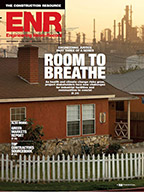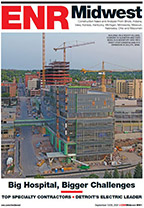While discussing sustainability and construction’s role in enhancing it, the Top 20 team members did some creative thinking.
Five of the 2019 group addressed the topic of how industry, and governments at all levels, must encourage sustainable building practices. Above all, they agreed, construction should police itself.
“There’s so much waste in the processes that we use to get to the end product,” which has a huge impact on efficiency and cost, says Pasco Umbriac, Clark Construction Group LLC vice president. “It just seems crazy in 2019 that we still throw away packs of plywood every day,” he says.
Acentech architectural acoustics group director Benjamin Markham agrees, adding concerns about embodied carbon in materials discarded after demolitions.
The subject of waste led Umbriac to an idea: use of artificial intelligence (AI) to analyze building designs to find “commonalities” and be able to manufacture one-size-fits-most prefabricated components.
Team Sustainability
Benjamin Markham
Director, Architectural Acoustics Group, Acentech
Cambridge, Mass.
Ashley Lickliter
Vice President, Kimley-Horn
Richmond, Va.
Pasco Umbriac
Vice President, Clark Construction Group LLC
Bethesda, Md.
John Barry
Vice President, Thornton Tomasetti
New York City
Kelly Daniel
Austin Operations Manager/Client Account Manager, Kleinfelder
Austin, Texas
He suggests putting prior designs “into a virtual model and chopping them up,” noting that AI could identify all similar pieces, send specifications to a factory and manufacture components in bulk.
The contractor manager believes that building 1,000 copies of “the same four feet of wall” would reduce the “excess material” thrown away later.
True, the young professionals admit, it could be hard to convince designers and owners that a project’s components aren’t as unusual as they think.
A bigger hurdle, they believe, is that only regulations will force adoption of new products and processes. Otherwise, owners and team members would likely choose the cheapest, not greenest, options.
“I do many public projects, so I think I speak from a different perspective because we’re working with limited funds,” says Ashley Lickliter, Kimley-Horn vice president. “It’s like, if you decide to do Item X and that’s $15 million more, where’s the money coming from?”
The industry itself can and must influence policy, the group insists. “As the engineers in the room, we do have a role in helping to make sure that decision-makers and policymakers understand ideas like life-cycle costs,” Markham says.
But Umbriac counters: “I think there has to be a little bit of spin to the discussion—away from life-cycle costs—because sometimes, like with an envelope system,” long-term payback can be minimal “compared to the up-front investment.”
His suggestion is to create more incentives such as tax credits and other approaches to drive down first costs.
After Superstorm Sandy pounded the East Coast in 2012, officials and project owners got serious about flood damage-resistant construction. “In New York City, it seems every project I have has some flood component to it,” Thornton Tomasetti vice president John Barry says. “It’s almost becoming routine in the city—floodwalls, flood logs at doors …and raising ground floors when possible.”
Barry also points out that to improve energy conservation, it makes more sense to swap out facades than windows, and Clark Construction’s Umbriac adds that his firm has been replacing the envelope systems of many buildings.
Lickliter of Kimley-Horn notes that in historical areas such as greater Richmond, Va., that has to be done while also observing community demands for both new and renovated buildings to harmonize with what came before—like the distinctive exterior red brick of old tobacco warehouses.
Carbon Footprint
When talk turns to environmentally friendly materials, Kleinfelder Austin operations manager Kelly Daniel, also a geologist, excites her peers with an idea that’s just starting to gain traction in the industry.
“It would be really interesting if we started to assign value to materials, such as a carbon footprint [number], like we do with health and safety metrics,” she says. Some clients pick contractors based on their safety record, she notes.
“If we had a carbon impact rating that drove some decision-making, developers, governments and other entities would likely be excited to use the system to develop cleaner practices.” But Daniel adds: “We’d have to have … a regulatory entity that would drive it.”
Finally, the group debated broader issues of sustainability, such as how two-thirds of the global population could live in cities by 2030. Besides constructing viable mass transportation, changing zoning codes to create mixed-use areas would, for example, allow parents to live within walking or bicycling distance of their children’s day care and a quick train to work.
But there’s another benefit, particularly when eliminating zoning for single-family structures, as was done under recent laws enacted in Oregon and Minneapolis.
As Barry explains: “Allowing density or actually stopping non-density is a way to bring different socioeconomic classes together.”
Backstory
Benjamin Markham once performed for Pope John Paul II as part of a choir.
Ashley Lickliter went to college to be a veterinarian.
Pasco Umbriac helped build a tree house for a 10-year-old cancer patient that included a 14-ft spiral slide and stargazing platform.
John Barry has performed at Carnegie Hall and Lincoln Center with the Oratorio Society of New York and is restoring his 1925 landmarked house in Sunnyside, N.Y.
Kelly Daniel grew up sailing on the 19th-century tall ship Elissa in Galveston, Texas.







Post a comment to this article
Report Abusive Comment